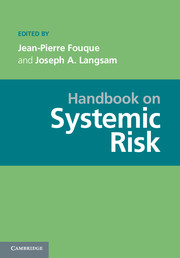Book contents
- Frontmatter
- Contents
- Contributors
- Introduction
- PART I DATA: THE PREREQUISITE FOR MANAGING SYSTEMIC RISK
- PART II STATISTICS AND SYSTEMIC RISK
- PART III MEASURING AND REGULATING SYSTEMIC RISK
- 8 Measuring Systemic Risk
- 9 Taxing Systemic Risk
- 10 Analyzing Systemic Risk of the European Banking Sector
- PART IV NETWORKS
- PART V SYSTEMIC RISK ANDMATHEMATICAL FINANCE
- PART VI COUNTERPARTY RISK AND SYSTEMIC RISK
- PART VII ALGORITHMIC TRADING
- PART VIII BEHAVIORAL FINANCE: THE PSYCHOLOGICAL DIMENSION OF SYSTEMIC RISK
- PART IX REGULATION
- PART X COMPUTATIONAL ISSUES AND REQUIREMENTS
- PART XI ACCOUNTING ISSUES
- References
8 - Measuring Systemic Risk
from PART III - MEASURING AND REGULATING SYSTEMIC RISK
Published online by Cambridge University Press: 05 June 2013
- Frontmatter
- Contents
- Contributors
- Introduction
- PART I DATA: THE PREREQUISITE FOR MANAGING SYSTEMIC RISK
- PART II STATISTICS AND SYSTEMIC RISK
- PART III MEASURING AND REGULATING SYSTEMIC RISK
- 8 Measuring Systemic Risk
- 9 Taxing Systemic Risk
- 10 Analyzing Systemic Risk of the European Banking Sector
- PART IV NETWORKS
- PART V SYSTEMIC RISK ANDMATHEMATICAL FINANCE
- PART VI COUNTERPARTY RISK AND SYSTEMIC RISK
- PART VII ALGORITHMIC TRADING
- PART VIII BEHAVIORAL FINANCE: THE PSYCHOLOGICAL DIMENSION OF SYSTEMIC RISK
- PART IX REGULATION
- PART X COMPUTATIONAL ISSUES AND REQUIREMENTS
- PART XI ACCOUNTING ISSUES
- References
Summary
Abstract The most important lesson from the financial crisis of 2007 to 2009 has been that failures of some large financial institutions can impose costs on the entire system. We call these systemically important financial institutions (SIFIs). Their failures invariably put regulators in a compromised situation since, absent prearranged resolution plans, they are forced to rescue the failed institutions to preserve a functioning financial system. In the recent crisis, this has involved protecting not just insured creditors, but sometimes uninsured creditors and even shareholders. The anticipation that these bailouts will occur compromises market discipline in good times, encouraging excessive leverage and risk taking. This reinforces the systemic risk in the system. It is widely accepted that systemic risk needs to be contained by making it possible for these institutions to fail, thus restraining their incentives to take excessive risks in good times. First and foremost, however, regulators need to ascertain which institutions are, in fact, systemically important. Indeed, the systemic risk of an individual institution has not yet been measured or quantified by regulators in an organized manner, even though systemic risk has always been one of the justifications for our elaborate regulatory apparatus.
There are some institutions that follow highly cyclical activities and are thus heavily correlated with aggregate economic conditions. If these institutions are also highly levered, especially with short-term debt, then they face runs in the event of sufficiently adverse news about their condition.
- Type
- Chapter
- Information
- Handbook on Systemic Risk , pp. 196 - 225Publisher: Cambridge University PressPrint publication year: 2013
References
- 2
- Cited by



